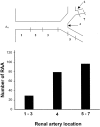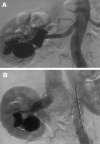Renal artery aneurysms: a 35-year clinical experience with 252 aneurysms in 168 patients
- PMID: 11573039
- PMCID: PMC1422069
- DOI: 10.1097/00000658-200110000-00005
Renal artery aneurysms: a 35-year clinical experience with 252 aneurysms in 168 patients
Abstract
Objective: To define the relevance of treating renal artery aneurysms (RAAs) surgically.
Summary background data: Most prior definitions of the clinical, pathologic, and management features of RAAs have evolved from anecdotal reports. Controversy surrounding this clinical entity continues.
Methods: A retrospective review was undertaken of 168 patients (107 women, 61 men) with 252 RAAs encountered over 35 years at the University of Michigan Hospital. Aneurysms were solitary in 115 patients and multiple in 53 patients. Bilateral RAAs occurred in 32 patients. Associated diseases included hypertension (73%), renal artery fibrodysplasia (34%), systemic atherosclerosis (25%), and extrarenal aneurysms (6.5%). Most RAAs were saccular (79%) and noncalcified (63%). The main renal artery bifurcation was the most common site of aneurysms (60%). RAAs were often asymptomatic (55%), with a diagnosis made most often during arteriographic study for suspected renovascular hypertension (42%).
Results: Surgery was performed in 121 patients (average RAA size 1.5 cm), including 14 patients undergoing unilateral repair with contralateral RAA observation. The remaining 47 patients (average RAA size 1.3 cm) were not treated surgically. Operations included aneurysmectomy and angioplastic renal artery closure or segmental renal artery reimplantation, aneurysmectomy and renal artery bypass, and planned nephrectomy for unreconstructable renal arteries or advanced parenchymal disease. Eight patients underwent unplanned nephrectomy, being considered a technical failure of surgical therapy. Dialysis-dependent renal failure occurred in one patient. There were no perioperative deaths. Late follow-up (average 91 months) was available in 145 patients (86%). All but two arterial reconstructions remained clinically patent. Secondary renal artery procedures included percutaneous angioplasty, branch embolization, graft thrombectomy, and repeat bypass for late aneurysmal change of a vein conduit. Among 40 patients with clearly documented preoperative and postoperative blood pressure measurements, 60% had a significant decline in blood pressure after surgery while taking fewer antihypertensive medications. Late RAA rupture did not occur in the nonoperative patients, but no lessening of this group's hypertension was noted.
Conclusion: Surgical therapy of RAAs in properly selected patients provides excellent long-term clinical outcomes and is often associated with decreased blood pressure.
Figures







Similar articles
-
Reconstruction for renal artery aneurysm: operative techniques and long-term results.J Vasc Surg. 2003 Feb;37(2):293-300. doi: 10.1067/mva.2003.117. J Vasc Surg. 2003. PMID: 12563198
-
Favorable outcomes with in situ techniques for surgical repair of complex renal artery aneurysms.J Vasc Surg. 2011 Mar;53(3):684-91. doi: 10.1016/j.jvs.2010.10.050. Epub 2010 Dec 8. J Vasc Surg. 2011. PMID: 21144690
-
Aneurysmectomy with arterial reconstruction of renal artery aneurysms in the endovascular era: a safe, effective treatment for both aneurysm and associated hypertension.Ann Vasc Surg. 2010 May;24(4):503-10. doi: 10.1016/j.avsg.2009.07.030. Epub 2009 Dec 29. Ann Vasc Surg. 2010. PMID: 20036510
-
Intraparenchymal renal artery aneurysms. Case report with review and update of the literature.Int Urol Nephrol. 2004;36(3):409-16. doi: 10.1007/s11255-004-8871-2. Int Urol Nephrol. 2004. PMID: 15783117 Review.
-
Popliteal artery aneurysms. Factors associated with thromboembolism and graft failure.Int Angiol. 2004 Mar;23(1):54-65. Int Angiol. 2004. PMID: 15156131 Review.
Cited by
-
Hybrid Treatment of Coexisting Renal Artery Aneurysm and Abdominal Aortic Aneurysm in a Gallbladder Cancer Patient.Vasc Specialist Int. 2014 Jun;30(2):68-71. doi: 10.5758/vsi.2014.30.2.68. Epub 2014 Jun 30. Vasc Specialist Int. 2014. PMID: 26217619 Free PMC article.
-
Transcatheter renal interventions: a review of established and emerging procedures.J Clin Imaging Sci. 2015 Jan 30;5:5. doi: 10.4103/2156-7514.150448. eCollection 2015. J Clin Imaging Sci. 2015. PMID: 25806140 Free PMC article. Review.
-
Embolization of ruptured renal artery aneurysms.Clin Exp Nephrol. 2015 Oct;19(5):901-8. doi: 10.1007/s10157-015-1087-1. Epub 2015 Jan 25. Clin Exp Nephrol. 2015. PMID: 25618494
-
Is it renal colic or ruptured dissecting aneurysm of renal artery?: A case report.Cases J. 2009 Dec 24;2:9398. doi: 10.1186/1757-1626-2-9398. Cases J. 2009. PMID: 20072684 Free PMC article.
-
Surgical Treatment of Celiacomesenteric Trunk Aneurysm: Report of 2 Cases.Am J Case Rep. 2020 Nov 6;21:e927077. doi: 10.12659/AJCR.927077. Am J Case Rep. 2020. PMID: 33154344 Free PMC article.
References
-
- Stanley JC, Rhodes EL, Gewertz BL, et al. Renal artery aneurysms. Significance of macroaneruysms exclusive of dissections and fibrodysplastic mural dilations. Arch Surg 1975; 110: 1327–1333. - PubMed
-
- Dzsinich C, Gloviczki P, McKusick MA, et al. Surgical management of renal artery aneurysm. Cardiovasc Surg 1993; 1: 243–247. - PubMed
-
- Martin RS, III, Meacham PW, Ditesheim JA, et al. Renal artery aneurysm: selective treatment for hypertension and prevention of rupture. J Vasc Surg 1989; 9: 26–34. - PubMed
-
- Soussou ID, Starr DS, Lawrie GM, et al. Renal artery aneurysm: long-term relief of renovascular hypertension by in situ operative correction. Arch Surg 1979; 114: 1410–1415. - PubMed
-
- Hageman JH, Smith RF, Szilagyi DE, et al. Aneurysm of the renal artery: Problems of prognosis and surgical management. Surgery 1978; 84: 563–572. - PubMed
Publication types
MeSH terms
LinkOut - more resources
Full Text Sources
Medical

